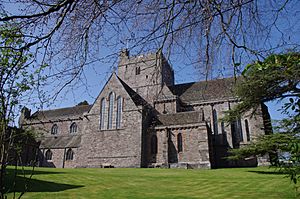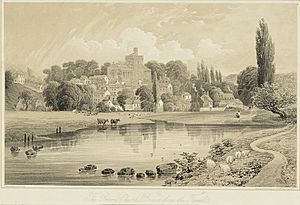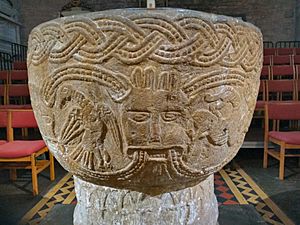Brecon Cathedral facts for kids
Quick facts for kids Brecon Cathedral |
|
|---|---|
| Cathedral Church of St John the Evangelist | |

Brecon Cathedral
|
|
| ACoordinates: Unknown argument format |
|
| Location | Brecon |
| Country | Wales |
| Denomination | Church in Wales |
| Previous denomination | Catholic |
| History | |
| Dedication | John the Evangelist |
| Architecture | |
| Heritage designation | Grade I listed building |
| Designated | 16 January 1952 |
| Administration | |
| Diocese | Diocese of Swansea and Brecon (since 1923) |
| Province | Church in Wales |
Brecon Cathedral (which is Eglwys Gadeiriol Aberhonddu in Welsh) is a very important church in the town of Brecon, Powys, Wales. It is the main church for the Diocese of Swansea and Brecon within the Church in Wales. This means it's where the Bishop of Swansea and Brecon has their official seat.
Before it became a cathedral, it was first a priory church and then a regular parish church called St John the Evangelist. It officially became Brecon Cathedral in 1923. This happened after the Church in Wales became separate from the Church of England in 1920.
Contents
A Look at Brecon Cathedral's Past
The churchyard around Brecon Cathedral is round. This special shape makes people think there might have been an even older Celtic church on this spot many centuries ago. However, no parts of that very old church remain today.
Building the First Church
A new church, dedicated to John the Evangelist, was built here around 1093. This was ordered by Bernard de Neufmarché, a Norman knight. He had recently taken control of the area known as Brycheiniog. Bernard gave the church to a monk named Roger from Battle Abbey. Roger then started a priory here, which was like a smaller branch of Battle Abbey. The first leader of the priory was Walter, another monk from Battle.
Bernard de Neufmarché also gave the priory land and money. After he passed away, the priory became connected to the Earls of Hereford, which helped it become even more successful.
Changes Over Time
The church was rebuilt and made bigger in the Gothic style around 1215. This was during the time of King John. In the Middle Ages, the church was known for having a large "golden rood" (a type of cross). People would travel to see it as a special religious object. However, this rood was destroyed in the 1500s when many monasteries were closed down. The roof of the church's main hall was built between 1237 and 1267.
In 1538, the priory church became a regular parish church for the local community. Some of the buildings around it were used for other purposes, while others, like the cloisters (covered walkways), were left to fall apart.
Restoration and Modern Use
By the 1800s, the church was in poor condition. Only the main part, called the nave, was being used. Some repairs happened in 1836, but major work to fix up the church didn't start until the 1860s. The church's tower was made stronger in 1914.
Brecon Cathedral is considered a Grade I listed building. This means it's a very important historical building that needs to be protected.
In recent years, some of the buildings near the cathedral have been turned into useful spaces. These include a center for the diocese, a heritage center with exhibitions, a shop, and a restaurant.
A soldier named Charles Lumley (1824–1858), who received the Victoria Cross for his bravery in the Crimean War, is buried in the cathedral churchyard.
Leaders of Brecon Cathedral
The main leader of Brecon Cathedral is called the Dean. The current Dean is Dr. Paul Shackerley, who started in this role in September 2014.
Music at the Cathedral
Brecon Cathedral has a large pipe organ. You can find details about this organ on the National Pipe Organ Register.
Organists of Brecon Cathedral
Many talented musicians have served as the organist at Brecon Cathedral over the years. Some of them include:
- John Humphrey Carden (from 1923)
- David Gwerfyl Davies (from 1956)
- Michael Bryan Hesford (from 1963)
- David Patrick Gedge (from 1966)
- Mark Duthie (from 2007)
- Stephen Power (from 2017)
The Cathedral Bells
The cathedral has 10 bells. These bells are rung in a special way called "full-circle ringing." The heaviest bell weighs about 16 hundredweight (which is about 813 kilograms).



